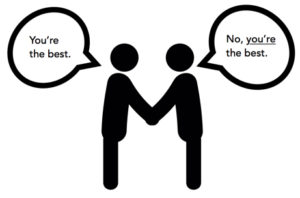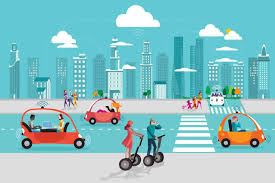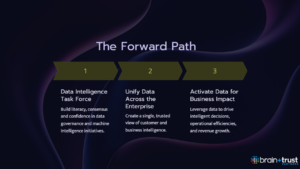I talk just about every day with brand-managing friends, colleagues and complete strangers on planes (they start it – I’m not a chatty seat-mate) about what digital transformation actually means and how to set priorities in the current business ecosystem. We’re drowning in data, confronted by endless technological advances and under immense pressure to improve customer experience. Most days I feel more like a therapist than a marketer.
I can’t blame anyone for wanting to run when digital transformation is brought up. Or to hunker down & count the seconds until retirement, pinning the responsibility on the next gal or guy in line. It’s a daunting subject. But flip the way you think about where we are and where we’re going. Make the responsibility for leading the charge an honor instead of an albatross. We all have to learn to love being uncomfortable and many of us will have to make big decisions that make others uncomfortable, even angry. Despite the upset, technology isn’t going to stop. It doesn’t care if we’re comfortable.
The top priority in digital transformation is letting go of old habits and committing to a positive, future-ready mindset. It will not only make things easier on you and your team, it will help you keep your job because you’ll drive revenue more effectively. As we march full steam ahead into 2020, consider making the flip. Set your brand and yourself up for what’s next. Start with these five things:

One – Put Your House in Order
The cost, frustration and number of opportunities missed because data is siloed, housed in legacy systems and/or is inaccessible to relevant cross-departmental teams is soul-crushing… and revenue-crushing. If your brand doesn’t have a consumer data platform (CDP) in place, start the review process now. Commit to on-boarding one in 2020.
Lean on the CDP Institute for vendor-neutral information and leverage consultants to avoid wasting time and money. Be wary of ‘SMEs’ that push prescriptive solutions only they can fill and the rip and replace crowd. Understand the power and savings to be found using schemaless solutions and know upfront that most claiming to be a CDP really aren’t – they’re partially-inclusive data lakes or any number of things far less useful than they appear. Never sign a contract without chatting on entity resolution, and remember that Google is killing cookies in 2022. So, you’re on the clock.

Two – Re-engineer your Agency Relationships
If you retain an agency, as most do, that relationship shouldn’t look the same way it did 10 years ago. Data has changed the fundamental nature of marketing and media and how brands and agencies should work together. To boot, most vendors are positioning themselves as agencies. They introduce slanted recommendations and layers of hidden commissions throughout the media investment process.
Some brands have moved to in-house teams to curb wasteful spending and better govern their data, running the risk of becoming predictable and committing to huge capital investments. Others still outsource everything to agencies and consistently feel out of control. There is no single ‘right answer’ to how your agency relationship should be structured, but take an honest look at your goals, your gaps and run a modern version of the tried-and-true cost-benefit analysis. That work will likely lead you to build a hybrid team.
In-house talent can live and breathe your brand, leveraging data to impact not only marketing, but product development, customer care, consumer experience and more. Your agency can bring diversity in thought and a non-linear mindset forward. Agency talents work in auto, travel, insurance, retail, finance, on brands large and small, and that breadth and variety of experience builds excellence in content, creative, strategy and media. There’s a reason Austin Kleon says Steal Like an Artist. If you’ve chosen the right agency partner, they can and will make the difference for your brand in a way only agency professionals can.
If you decide to run a hybrid team, make sure communication is strong and consistent and that everyone understands their role. Agencies – don’t be afraid to talk about fair compensation. Brands – realize that reporting now needs to flow both ways… you owe your agencies insights all the way through to business outcomes so that they can do the job you hired them to do.

Three – Tend Your Sonic Garden
Brands spend millions developing their visual identities – the dream logo, an unmistakable font, a one-of-a-kind brand personality. As we witness the renaissance of audio and the rise of voice, though, a visual identity isn’t enough. Consumers must also know what you sound like. Large brand or small, you need a sonic identity. If you’re an enterprise-level company, think sonic ecosystem – expansion of your DNA to maximize impact via multiple touch-points, building a personal, emotional connection with your consumers.
Brands like McDonald’s, Intel and Coca-Cola are ahead of you in this space, prepared for smart speakers, the rise of podcasts and the proliferation of voice-controlled connected devices. That’s fine, as they’re likely ahead of you in other ways, too – they’ve had decades to build their brands. If you’re a SMB starting from scratch, or a corporation optimizing work already done in the sonic space, remember that your audio DNA should be drafted and protected just like your visual identity. It’s a long-term play and consistency is key.
Avoid reliance on short-term fads, like pop songs and YouTube video tracks, instead opting for original voices, sounds and music. Be bold. Conservative audio is boring and you will be dismissed as part of the corporate clutter if your sound is average. Lastly, conduct a customer experience audit to understand every touch-point where audio is in play, from brick-and-mortar locations to customer care lines to paid, earned and owned media… this isn’t just about the music bed in your radio ad.

Four – Understand Mobility
Mobility may be the single most important subject to study if you sell anything at all. Changes in mobility are fueled by technology, of course, but consider the breadth and impact of the subject. Mobility isn’t just how we physically get from point A to point B, though that’s a big part of it. It’s about transportation, commerce, access to data and information, infrastructure, the workforce and shifts in consumer expectations. Mobility means people aren’t just moving differently, they’re thinking differently.
I received an unsolicited call from a major US retailer last month, inquiring about my interest in joining their corporate business transformation team (to overcome the retail apocalypse). I heard them out and the terms of employment were shockingly generous. Then this happened:
[box] Employees are to be in the office 8a-5p Mon-Fri, without exception. Employees may not work from home.[/box]
This wasn’t a brand dealing with sensitive financial, national security or medical information. I’ll go out on a limb and say no one walks their halls with an air-gapped laptop to protect table lamp and scented candle data. In this single statement, that had nothing to do with transportation, or marketing, the brand showed me that they don’t understand mobility, or the far-reaching impact it has on their company internally and externally. I ended the conversation with a heavy heart, wishing them the best, knowing their brand will continue to struggle until they embrace the change that none of us can avoid.
If you don’t talk about mobility in your marketing department, start in 2020. It should be a part of your strategy and planning protocols, as it is at the root of human behavior. Assess and consider, consistently, technological advances, legislation and trends involving subjects like drones, autonomous vehicles, shared mobility services, 5G, smart devices, satellites, employment/recruiting practices and supply chain. Identify how these things have changed, or will change, and the impact on the expectations and journeys of your consumers, your employees and your vendor partners. Optimize your efforts to maximize engagement and reduce friction.

Five – Make Super Friends
If you haven’t envisioned your brand’s potential in the super app environment, do it now. How might your brand contribute within a super app? Where are the obvious alliances with other brands and platforms? More importantly, where are the less obvious ones? Teams are forming and under these circumstances your network is your net worth. New partnerships and the reinvention of current relationships will enable discovery of additional revenue streams and ensure your brand maintains relevance as consumer journeys continue to change.
Consider that in 2019 the average US adult spent 3:43 a day on a mobile device. Of that time, 2:57 minutes were spent in apps. All this as most apps in the US are limited to providing a few products or services and friction levels with usage can be high (you may need any one of seven apps to unlock the scooter in front of you in Austin, TX… ugh). As the super apps rise in the US, inconvenience will further fade away and your brand will either be a part of the deliverable or it won’t. I hate to think how much it will cost to capture a consumer’s attention outside of the super apps, once they have a foothold in the US, as American consumers already spend 80% of their time in apps with limited capabilities.
In 2020, understand the value of your current data sets and how alignment with other information, such as traffic patterns and weather, can enhance your ability to understand and serve consumers. Forge new relationships with smart people and savvy brands, even if they don’t immediately deliver new business opportunities. No matter what the future holds, you want to be top-of-mind and recognized for your forward-thinking mindset. Be everyone’s first phone call.







